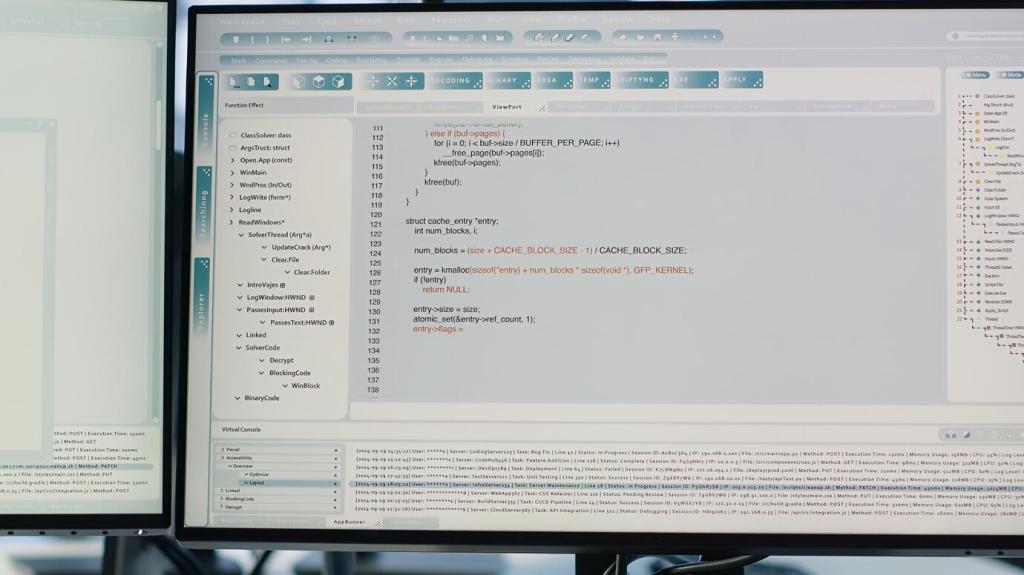
Introduction to Open-Source Software
Open-source software has fundamentally changed the landscape of technology and digital collaboration. It refers to software with source code that anyone can inspect, modify, and enhance. This openness fosters a culture of transparency, accessibility, and collective innovation. Developers, enthusiasts, and organizations around the globe contribute to open-source projects, leading to rapid advancements and widespread adoption. Understanding the principles and impact of open-source software is crucial for anyone interested in technology today, as it shapes everything from operating systems to cutting-edge applications and services.

Defining Open-Source Principles
The core principles of open-source software revolve around freedom of use, access to the source code, collaborative development, and the ability to redistribute copies. These principles ensure that software innovation is not confined to any single company or individual. Instead, ideas and improvements are shared openly, enabling a more dynamic and inclusive technological ecosystem. The open-source approach promotes transparency, which has a profound impact on security, reliability, and trust. As a result, users benefit from both continuous improvements and the collective expertise of the global developer community.
Historical Background
The origins of open-source software can be traced back to the early days of computing, where sharing code was commonplace among researchers and academics. The Open Source Initiative, founded in 1998, formalized the definition and advocacy of open-source practices. Key events, such as the release of the source code for the Netscape browser and the rise of projects like Linux and Apache, catalyzed widespread interest and participation. These milestones set the stage for a movement that now underpins much of today’s software infrastructure, making open-source a dominant force in technological innovation.
Importance in the Modern Era
Open-source software has grown to become a cornerstone of modern technology infrastructure. From operating systems like Linux that power data centers worldwide to programming languages such as Python and JavaScript, its impact is far-reaching. It enables startups, enterprises, and individual developers to leverage robust and cost-effective tools, accelerating innovation. In a rapidly changing digital environment, the adaptability, scalability, and security offered by open-source projects ensure their continued relevance. Embracing open-source is essential for organizations aiming to stay competitive and resilient in the digital age.

Accessibility and Transparency
One of the most significant attributes of open-source software is its accessibility to everyone. Anyone with an interest can view, download, and study the underlying source code. This transparency allows independent verification, improvement, and customization according to specific needs. As a result, users can have confidence in the security and integrity of the software. The open nature also facilitates peer reviews, making it easier to detect and address vulnerabilities—something not always possible with closed, proprietary alternatives.

Collaboration and Community Engagement
Another hallmark of open-source software is the culture of collaboration it fosters. Communities form around projects, comprised of developers, testers, and users from all over the world. These communities are often self-organizing, with roles and contributions based on interest and expertise rather than formal hierarchy. The collective intelligence and diversity within these groups lead to enhanced innovation, faster bug fixes, and more inclusive development processes. The strength and vitality of an open-source project are often reflected in the size and activity of its community.

Freedom to Customize and Share
Open-source licensing ensures that users are free to modify software to suit their unique requirements and to share their changes with others. This freedom is crucial for organizations with specific operational needs that cannot be met by generic solutions. It also encourages the creation of derivative works, or forks, which allow new and specialized features to emerge. The ability to share improvements ensures that the benefits of innovation are distributed across the entire ecosystem, rapidly advancing collective technological capabilities.
Common Types of Open-Source Licenses
Permissive Licenses
Permissive licenses, such as the MIT and Apache licenses, are among the most flexible in the open-source world. They allow nearly unrestricted use, modification, and distribution of software, including integration into proprietary products. The primary conditions often relate to proper attribution and sometimes the inclusion of the license text. These licenses promote broad adoption and compatibility, making it easier for individuals and companies to incorporate open-source code into a wide array of projects without excessive legal concerns.


Copyleft Licenses
Copyleft licenses, like the GNU General Public License (GPL), require that derivative works also remain open source and licensed under the same terms. This ensures that the freedoms associated with the original work are preserved in all subsequent versions and adaptations. While this model encourages ongoing openness and sharing, it introduces more complex legal considerations for developers who wish to combine open-source code with proprietary elements. Copyleft licenses play a critical role in maintaining the open-source ethos across generations of software.
The Role of Community in Open-Source Projects
Contribution and Participation
Open-source communities thrive on the diverse contributions of individuals and organizations. Contributions can take many forms beyond coding, including documentation, bug reporting, testing, design, and outreach. Contributors often find mentorship and learning opportunities, building valuable skills and professional networks. Participation is typically merit-based, allowing anyone to earn recognition and responsibility through sustained effort. This inclusive atmosphere attracts a wide range of backgrounds, which in turn drives innovation and problem-solving.
Governance and Decision-Making
Effective open-source projects require clear governance models to manage decision-making and mediate conflicts. These models range from informal consensus-building to structured leadership councils or foundations. Transparent processes help maintain trust and ensure that the project aligns with the community’s goals and values. Some projects appoint maintainers or use voting systems to approve major changes, while others rely on broader community input. Strong governance is key to scaling a project and handling growth or challenges sustainably.
Support and Knowledge Sharing
Open-source communities are well-known for their commitment to support and knowledge transfer. Forums, mailing lists, and chat platforms provide vibrant spaces for users and developers to seek help, share best practices, and discuss improvements. This ongoing exchange of information both lowers barriers to entry for newcomers and fosters a culture of continuous learning. The combined expertise of the community makes open-source software resilient and responsive to evolving needs, reinforcing long-term viability.
Benefits of Using Open-Source Software
Cost Efficiency and Flexibility
Open-source software is often available at little to no direct cost, which can substantially lower the total cost of ownership for individuals and organizations. The absence of licensing fees enables users to deploy solutions across as many devices or users as needed without incurring additional charges. Furthermore, the freedom to modify and adapt open-source software allows businesses to fine-tune applications to perfectly fit their workflows. This flexibility ensures that users are not locked into rigid licensing models or limited by vendor-imposed constraints.
Security and Reliability
Security is a prominent benefit of open-source software due to its transparent development process. With many eyes scrutinizing the code, vulnerabilities tend to be discovered and addressed swiftly. Regular updates and community-driven testing enhance the reliability and stability of open-source solutions. Organizations are not dependent on the timeline of a single vendor for critical patches, which reduces risk. Over time, open-source software often proves as resilient—if not more so—than proprietary counterparts, earning the trust of enterprises seeking robust technology foundations.
Innovation and Rapid Development
The vibrant community behind open-source projects drives continual innovation and improvement. Ideas and features can be discussed, developed, and integrated at an accelerated pace compared to closed systems. Open collaboration allows new technologies to be rapidly prototyped and deployed, keeping software at the forefront of industry trends. This culture of experimentation invites creative solutions to complex problems, and the rapid iteration cycles make it easier for software to meet changing user needs and market demands.
Challenges and Considerations
Maintaining an active and vibrant open-source community requires ongoing engagement and, often, reliable funding sources. Many open-source projects rely on volunteer effort, which can be difficult to sustain over long periods. Financial constraints can limit the ability to provide regular updates, documentation, or support. Projects may turn to foundations, sponsorships, or crowdfunding to bridge funding gaps. Ensuring the financial and human resources to support a project over the long term is a vital yet complex undertaking for the open-source ecosystem.
Popular Open-Source Projects and Tools
Linux, one of the most well-known open-source operating systems, powers the majority of the world’s servers and supercomputers. Its flexibility and wide hardware compatibility make it a backbone for everything from personal computers to enterprise data centers. Complementary tools like the Apache HTTP server and Nginx play a crucial role in web hosting and content delivery. These projects benefit from decades of community development, resulting in dependable and efficient platforms trusted by organizations of every size.
Many programming languages and development tools are products of open-source collaboration. Python has become ubiquitous thanks to its readability, extensive libraries, and active community, making it a preferred choice for everything from web development to artificial intelligence. Git, a distributed version control system, revolutionized how developers manage and collaborate on code. These tools are accessible, customizable, and continually evolving, providing users with cutting-edge capabilities at no direct cost.
Open-source applications rival their commercial counterparts in functionality and ease of use. The LibreOffice suite offers a comprehensive set of productivity tools suitable for both home and professional environments. GIMP provides advanced image editing features, while VLC Media Player delivers broad multimedia compatibility. By leveraging community feedback and contributions, these applications are able to stay current, address user needs, and remain free from restrictive licensing models.
Getting Involved With Open-Source Software
Finding Projects to Contribute To
With thousands of active open-source projects, finding one that matches your interests and skills is easier than ever. Popular platforms such as GitHub and GitLab provide repositories where you can browse, clone, and work on projects covering a broad spectrum of topics. Project documentation often includes guides for newcomers, ensuring a smooth onboarding process. Whether you’re interested in bug fixes, new features, or documentation, every contribution helps strengthen the project and welcome new community members.

